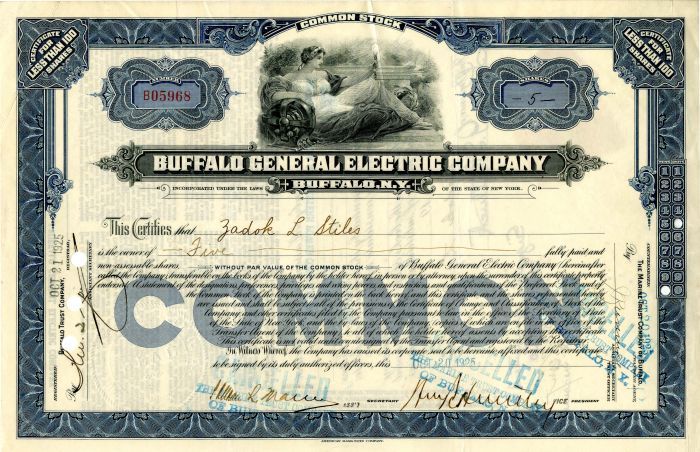Buffalo General Electric Co. - Stock Certificate
Inv# US1096 Stock
Stock printed by American Bank Note Company.
At the start of the 20th century, Buffalo was the world's leading grain port and a national flour-milling hub. Local mills were among the first to benefit from hydroelectricity generated by the Niagara River. Buffalo hosted the 1901 Pan-American Exposition after the Spanish–American War, showcasing the nation's advances in art, architecture, and electricity. Its centerpiece was the Electric Tower, with over two million light bulbs, but some exhibits were jingoistic and racially charged. At the exposition, President William McKinley was assassinated by anarchist Leon Czolgosz. When McKinley died, Theodore Roosevelt was sworn in at the Wilcox Mansion in Buffalo.
Attorney John Milburn and local industrialists and convinced the Lackawanna Iron and Steel Company to relocate from Scranton, Pennsylvania to the town of West Seneca in 1904. Employment was competitive, with many Eastern Europeans and Scrantonians vying for jobs. From the late 19th century to the 1920s, mergers and acquisitions led to distant ownership of local companies; this had a negative effect on the city's economy. Examples include the acquisition of Lackawanna Steel by Bethlehem Steel and, later, the relocation of Curtiss-Wright in the 1940s. The Great Depression saw severe unemployment, especially among the working class. New Deal relief programs operated in full force, and the city became a stronghold of labor unions and the Democratic Party.
During World War II, Buffalo regained its manufacturing strength as military contracts enabled the city to manufacture steel, chemicals, aircraft, trucks, and ammunition. The 15th-most-populous US city in 1950, Buffalo's economy relied almost entirely on manufacturing; eighty percent of area jobs were in the sector. The city also had over a dozen railway terminals, as railroads remained a significant industry.
The St. Lawrence Seaway was proposed in the 19th century as a faster shipping route to Europe, and later as part of a bi-national hydroelectric project with Canada. Its combination with an expanded Welland Canal led to a grim outlook for Buffalo's economy. After its 1959 opening, the city's port and barge canal became largely irrelevant. Shipbuilding in Buffalo wound down in the 1960s due to reduced waterfront activity, ending an industry which had been part of the city's economy since 1812. Downsizing of the steel mills was attributed to the threat of higher wages and unionization efforts. Racial tensions culminated in riots in 1967. Suburbanization led to the selection of the town of Amherst for the new University at Buffalo campus by 1970. Unwilling to modernize its plant, Bethlehem Steel began cutting thousands of jobs in Lackawanna during the mid-1970s before closing it in 1983. The region lost at least 70,000 jobs between 1970 and 1984. Like much of the Rust Belt, Buffalo has focused on recovering from the effects of late-20th-century deindustrialization.
A stock certificate is issued by businesses, usually companies. A stock is part of the permanent finance of a business. Normally, they are never repaid, and the investor can recover his/her money only by selling to another investor. Most stocks, or also called shares, earn dividends, at the business's discretion, depending on how well it has traded. A stockholder or shareholder is a part-owner of the business that issued the stock certificates.









Ebay ID: labarre_galleries